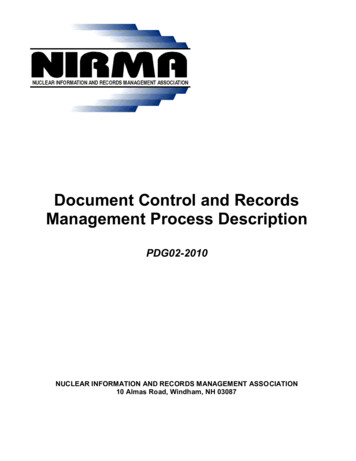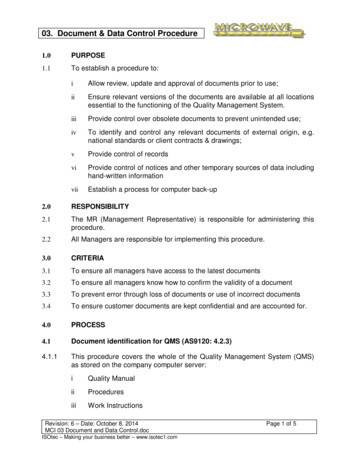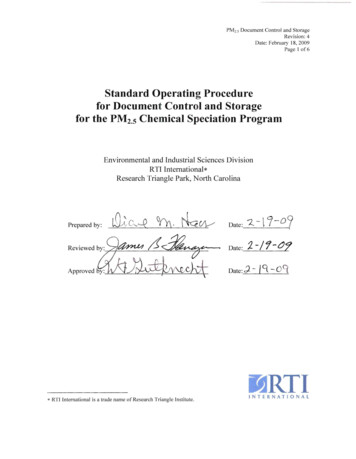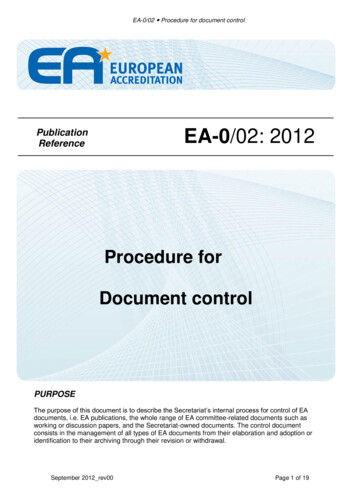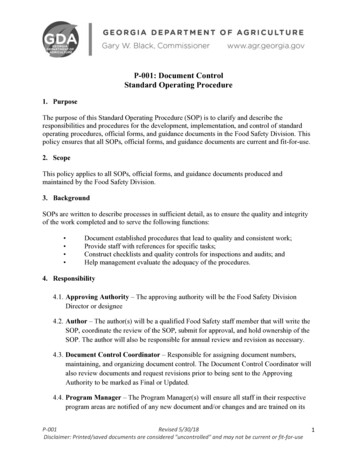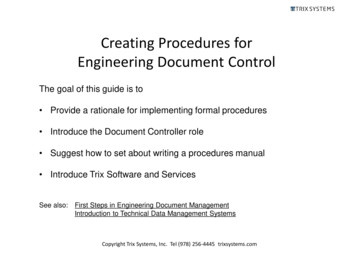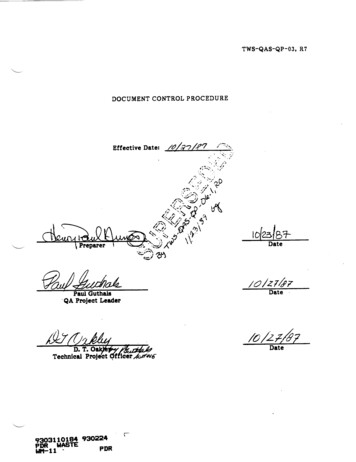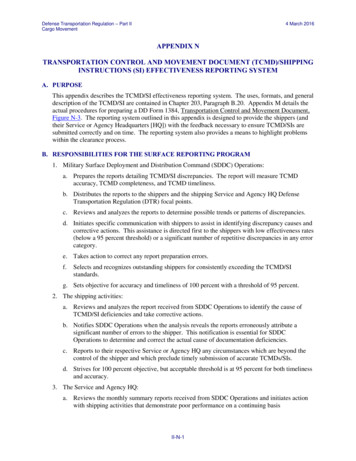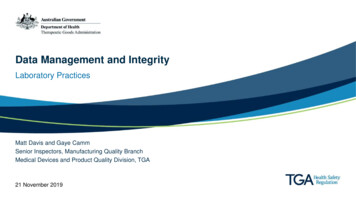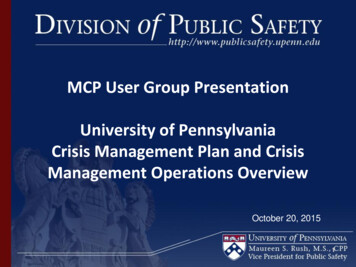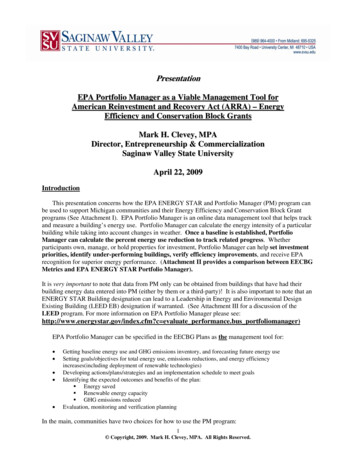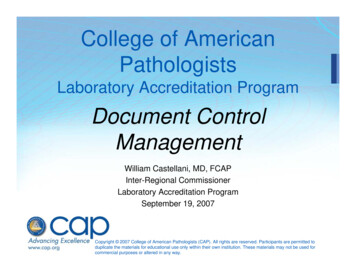
Transcription
College of AmericanPathologistsLaboratory Accreditation ProgramDocument ControlManagementWilliam Castellani, MD, FCAPInter-Regional CommissionerLaboratory Accreditation ProgramSeptember 19, 2007Copyright 2007 College of American Pathologists (CAP). All rights are reserved. Participants are permitted toduplicate the materials for educational use only within their own institution. These materials may not be used forcommercial purposes or altered in any way.
Learning Objectives Describe the CAP LAP checklistrequirements for document control List how policies, procedures, recordsand forms come under the documentcontrol requirements Discuss strategies and issues inimplementing a rigorous documentmanagement system.2
Document Control Is The process by which the instructions inuse can be assured to be current,correct and available.– Instructions for tasks (procedures)– Instructions for behaviors (policies)– Instructions for organization (processes)– And any associated material related tothese instructions3
Document Control Is Not The storage of data (records)– Caution: under CLIA and CAP guidelines,specific requirements exist for recordretention Limited to paper (hardcopy) Impossible to do with electronicdocuments4
Terminology (For This Talk) Must:– Required for compliance Should:– Recommended, often as a way to satisfy a“must” requirement– Best practice under the current “state-ofthe-art”– The laboratory may not feel that therecommendation is necessary5
GEN.20375Phase IIDoes the laboratory have a documentcontrol system?6
Document". any information or instructions includingpolicy statements, text books, procedures,specifications, calibration tables, biologicalreference intervals and their origins, charts,posters, notices, memoranda, software,drawings, plans, documents of external originsuch as regulations, standards, examinationprocedures.“—ISO/IEC 15189:2007, Section 4.3.1 Note7
GEN.20375Phase IINOTE: The laboratory should have a document management orcontrol system to assure that:1.All copies of policies and procedures are current;2.Personnel have read the policies/procedures relevant to theirjob activities;3.All policies/procedures have been authorized by thelaboratory director or designee before implementation;4.Policies and procedures are reviewed at least annually by thelaboratory director or designee;5.Discontinued policies/procedures are quarantined in aseparate file for a minimum of 2 years after the date ofdiscontinuation (5 years for Transfusion Medicine).8
GEN.20376Phase IIAre all quality management procedures, formsand records maintained under documentcontrol?Quality management documents are consideredequivalent to bench-level documents andsubject to the same document controlrequirements9
Life Cycle of a Document entIdeally, a policy that outlines processes,responsibilities and delegations, and compliancerequirements should be available and followed10
Initiation/Implementation rocess Flowchart/Procedure InstructionsReferences[Optional]: Related DocumentsAppendixes or Attachments Author Approval Signatures/Authorized—Modified from CLSI GP2-A511
Document Authorization CLIA’88: 42CFR493.1251– “(d) Procedures and changes in procedures must beapproved, signed, and dated by the current laboratorydirector before use.” Under laboratory director responsibilities(42CFR493.1445), the director maydesignate responsibilities, but– “(b) If the laboratory director reapportionsperformance of his or her responsibilities, he or sheremains responsible for ensuring that all duties areproperly performed.”12
Document Authorization For many laboratories, the director (as namedon the CLIA license) does not have theexpertise to evaluate documents for allsections– The appropriate section head may do so if thisindividual meets the CLIA qualifications for adirector Authorization may be on every document oron a summary document but each documentmust be authorized individually13
Electronic Signature Two distinct identification codes shouldbe used to identify the signer– Commonly, user name and password—21 CFR 11.200 Electronic signature components and controls14
Electronic Signature Signage of a single document during a periodof access requires entry of both codes tovalidate the signature Signage of multiple documents during a periodof access requires entry of both codes for thefirst document and entry of at least one of theidentification codes for each subsequentdocument—21 CFR 11.200 Electronic signature components and controls15
Electronic Signature The electronic signature must contain:– Printed name of the signer– Date and time when the signature wasexecuted– The meaning (authorship, authorization,review, revision) of the signature—21 CFR 11.50 Signature manifestations16
Document Use Training and review by personnel– The degree of direct training should be determinedby the director or designee– Review (and retraining if indicated) must berecorded The document must be readily available atthe bench– Primary hardcopy or current [controlled] copy– For electronic documents, access must not be lostdue to system failure Backup access does not necessarily need to be easy orconvenient, just possible and timely17
Document Use All versions of the document in usemust be current, including:– Photocopies/printed versions of electronicdocuments– Outlines or card file summaries– Personal notes18
Document Review Delegated responsibility Ideally, should be done by someoneactively using the document Changes should follow revision process– The specifics for revisions should bedescribed in the document control policy19
Document Review Occurs on an annual basis– There is no specific statement as to how long“annual” is– Should be explicitly stated in the policy– May be based on the date of authorization– May specify a window for completion– Checklist recommendation is to divide thedocuments into twelve groups, each groupdesignated for review during a specific month20
Refer toAttachment A
Refer toAttachment B
Document Review GEN.20375:“Electronic versions of procedures must besubjected to proper document control.Documentation of review of electronic proceduresmay be accomplished by including statementssuch as “reviewed by [name of reviewer] on [dateof review]” in the electronic record. Alternatively,paper review sheets may be used to documentreview of electronic procedures. Documentationof review by a secure electronic signature is NOTrequired.”23
Document RetirementGEN.20375:“ 5. discontinued policies/procedures are quarantinedin a separate file for a minimum of 2 years afterthe date of discontinuation (5 years forTransfusion Medicine).”The discontinued document must state the date itwas retired from useIf replaced by a new document, there should be areference to the prior, retired document24
“Appendices” Documents are legal material and need tofully represent the instructions that were to befollowed on each given day– Documents may reference package inserts; sincethese change over the lifetime of the document,the information in previous versions of thepackage inserts should be traceable– Documents may reference tables or graphs intextbooks; the original sources should be retainedin a specific location25
“Appendices” Some documents specify the use of certainforms– Generic/self-explanatory forms do not need to beunder document control LIS worksheets Blank templates for recording maintenance/temperaturedata– Specific forms, especially those with task-specificinstructions, should be either part of the parentdocument or retained in a specific location Instrument-specific maintenance forms Laboratory-designed forms with instructions for correctiveaction26
“Appendices” These supplemental documents need to bereferenced or reviewed for appropriatenessas part of the annual document review. The document control policy should stateexplicitly when signed review is required– Manufacturer’s current package insert– Explicitly identified vs free-standing supplementaldocument27
Stepping Beyond the Basics Document revision– It should be possible to reconstruct thecontents of the document in effect on anygiven day, in spite of later revision– Possible approaches: List each revision with effective date ofimplementation, prior text and revised text Maintain the earlier version as if it were “retired”28
Document Control Log A formal listing of current, valid copiesof all documents and their location– Should also list location of previousrevisions (if retained) and retireddocuments during the appropriate retentiontime “Non-controlled documents” are allcopies or transcriptions that are notmaintained in the document control log29
Handling Non-ControlledDocuments Forbid Disavow– “Official” copies– Make each person responsible for anycopies they maintain within the laboratory30
Handling “Ephemera” Documents contain standard operatingprocedures which need to be deviatedfrom at times– Temporary unexpected situations– Permanent changes that cannot wait forrevision of the document beforeimplementation31
“Ephemera” A record should be maintained of:– The deviation– The person initiating the deviation– All individuals affected (and, ideally,acknowledgement)– Expiration date of the deviation This should be explicitly stated in the initial deviation The deviation can be continued by re-authorizing if theconditions have not resolved by the expiration date (witha new expiration date)33
“Ephemera” The document control policy shouldspecify how such deviations should behandled– Who can initiate– How do the affected individualsacknowledge the change– How is the deviation documented andretained34
Summary Document control ensures that theinformation in use at any given day (ofrecord) is authorized, current, known bypersonnel, and reviewed for changes onan ongoing basis Although the design of the program isup to the laboratory, it should beformalized in a policy or procedure35
Summary Best practices ensure:– “Official” copies are tracked and keptconsistent– It is possible to reconstruct the instructionsin place at any time for any activity Forms Revisions Supportive material– A process is in place to control and recorddeviations from SOP36
References Clinical and Laboratory Standards Institute.Laboratory Documents: Development and Control;Approved Guideline –5th Edition [CLSI GP2-A5];Wayne PA, 2006 ISO/IEC 15189:2007. Medical Laboratories –Particular requirements for quality and competence Code of Federal Regulations. Title 21 – Food andDrugs: Chapter I – Food and Drug Administration,Part 11– Electronic Records; Electronic Signatures[21 CFR 11]37
Technical Assistance http://www.cap.org E-mail: accred@cap.org 800-323-4040, ext. 606538
Thank YouQuestionsandAnswers39
Medical Laboratories – Particular requirements for quality and competence Code of Federal Regulations. Title 21 – Food and Drugs: Chapter I – Food and Drug Administration, Part 11– Electronic Records; Electronic Signatures [21 CFR 11]
